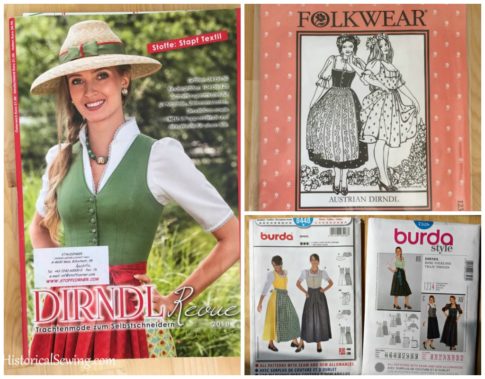
In the last few weeks I’ve been overloading on dirndl research…
You may have noticed this from my last post and from a recent Facebook Live video where I shared packages of official dirndl fabric from an online site based in Germany and two dirndl pattern magazines I ordered from Stoffcorner in Austria.
(FYI: that FB live video is just over an hour long but you’ll get lots of good tips and info!)
And then you may be following my new Dirndl Inspiration board on Pinterest. Go visit. Get inspired. 😉
As promised, this post will cover some pattern options to get you started on your own dirndl making journey.
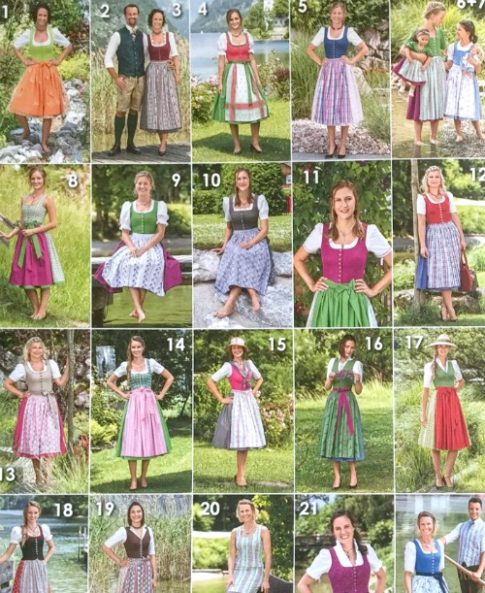
For a super brief overview, dirndls can be made in lengths from
-
- Above the knee (mini length and more Oktoberfest look)
-
- Midi length which is just below the knee to mid-calf (quite popular as a modern length for all ages)
- Long length which approaches the ankle (the most conservative styling and preferred by older women).
You’ll see patterns that give options for a single length or two lengths in one package. Although, chopping off or adding to a skirt and apron pattern piece is easy enough to do. So when deciding on a pattern to use I recommend looking at the style and cut of the bodice.
(Oh, and to clarify usage, the dirndl dress includes a “bodice” whereas the top worn underneath is the “blouse.” Coming from Victorian sewing I’ve called the shirt pattern a bodice but it should be referred to as blouse to make distinctions for fabric selections and fit.)
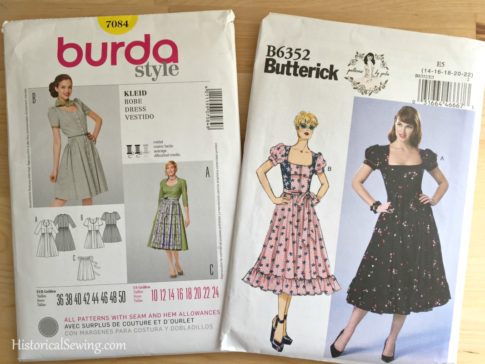
In addition, I have to mention this as it’s come up often in my research – contemporary dirndls are not limited to a blouse worn under a dress consisting of sleeveless, vest-type bodice and skirt with an apron on top.
Lots of complete dresses with bodice, sleeves and skirt elements worn with an apron can still be considered dirndl fashion. What sets them apart is fabric selections and, of course, wearing the apron with the dress.

One of the most popular and easily obtained patterns are those released by Burda Style. The magazine began in 1950 and is published from Germany where dirndl patterns, inspiration and tutorials are seen regularly.
Many of the Burda dirndl patterns can be found on their main website in PDF format or in their published magazine which includes full size pattern sheets for styles in that issue.
Simplicity is the main English-language distributor for Burda. For individually printed pattern envelopes, you can find them on the US Simplicity site (updated link October 2018) or the Simplicity UK site.
Oct 22, 2018 Edit: Simplicity has changed their site and it’s not easy now to locate Burda dirndl patterns there. If you have a pattern number, like one you see listed in this post, search for it with a “B” in front. Seems Simplicity has designated Burda patterns this way. So search “B7443” and the dirndl pattern *should* come up. The Burda 8448 was not coming up when I was searching for it. As always, a trip to a fabric shop that sells Burda patterns is good so you can look through the actual print catalog.
Search for “dirndl” on both the main Burda site and in Google to help you sift through the options. (Searching “dirndl” on the Simplicity site doesn’t really work.)
Also, scroll through the “dresses” category to see the current pattern offerings. And if anything, go to your local fabric store that carries Burda patterns and flip through the pattern book.
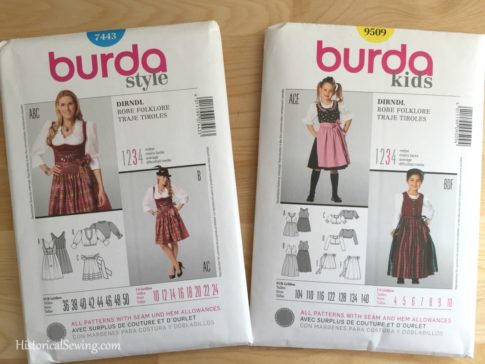
As commercial patterns don’t stick around for many years, the list of Burda pattern numbers below are for reference only. Although, you may try searching on Etsy and eBay for out of print patterns. Again, Burda releases dirndl patterns often – at least once a year from what I can tell – so you’ll nearly always find options for when you want to sew one up.
Burda 6268 – traditional “jumper dress” in the dirndl style cut with bust gussets; blouse and apron
Burda 7326 – traditional dirndl look with bodice and gored skirt; blouse and apron
Burda 8448 – traditional long dirndl with princess seams; blouse and apron
Burda 7084 – dirndl dress and apron
Burda 7870 – two-piece, long dirndl with bodice made separate from skirt; apron included
Burda 7443 – mini length with front bust gussets; blouse included
Burda Young 7057 – “folklore” dress that’s very Oktoberfest in styling
Burda Kids 9509 – traditional dirndl for girls size 4 to 10
Burda 8949 – jacket for wearing over dirndl in cooler weather

The next most-common dirndl sewing pattern is from Folkwear 123 – Austrian Dirndl. First published in 1980, it has remained a staple pattern for making dirndls for nearly 40 years.
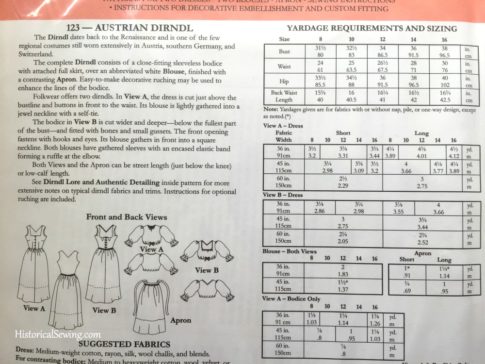
The size range is limited, however, with the bust sizes from 31.5” to 38”. (A plus-size version up to 48” bust would be so welcome if they ever decided to do that.)
The Folkwear pattern has a bodice with either small bust gussets or darts, two skirt lengths, apron and blouse. A good bargain with fabulous reviews if you fall in the size range.
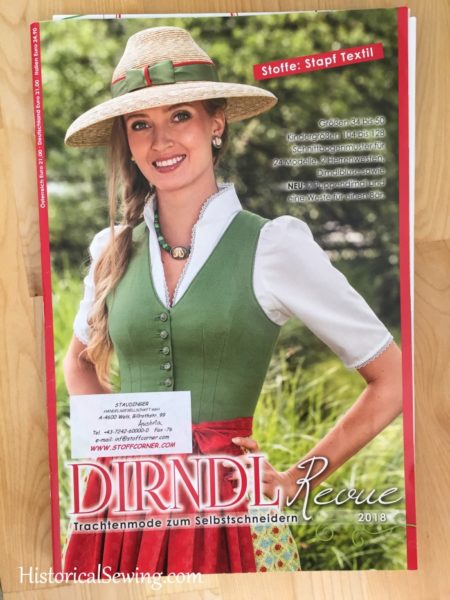
If Burda doesn’t get you to the source as much as you’d like, take a look at Dirndl Revue. It’s a publication from Stapf Textile in Tyrol, Austria that is similar to the Burda magazine.
Dirndl Revue is produced once a year and contains (generally) 18 to 24 “models.” Each model is a particular sewing pattern and can be made in the same fabrics shown when you purchase the fabric by the listed item numbers.
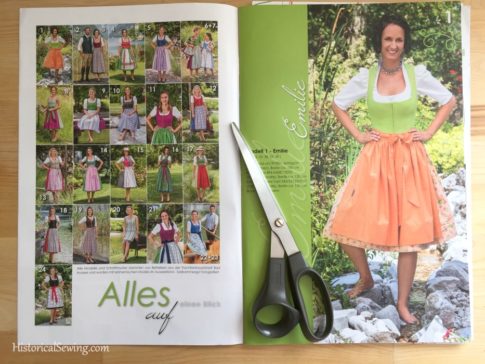
Each model/view pattern is layered, in full, graded sizes, on a couple of pattern sheets included in the magazine. You’ll need tracing paper of some sort to trace out your chosen model and size. Don’t get cross-eyed!

Along with the pattern sheets, the issues come with a pull-out of instructions and also flats of each model pattern shapes, fabric required, and brief sewing instructions for that view. This is truly helpful when you want to find a bodice with a certain fitting element (e.g. darts) quickly without having to decipher the fit seams in the photographs.
Speaking of photographs, they are beautiful in the publication!

Since I was ordering from Europe and paying a good amount for international postage, I ordered the Dirndl Revue for 2018 and 2016 – the older issue because it has six blouse patterns –whoot!
The models vary each year – as does dirndl fashion. You’ll find bodices with darts and/or princess seams, a blouse or two (or more like in 2016), instructions for aprons, and even the occasional dress, sheath dress, kids, men, and jacket patterns.
Scan the models for each year on Pinterest or the Stoffcorner website (which is where I purchased mine) to select which issue to order. Since one can only do so much with dart placement and necklines there’s bound to be repeats of models over the annual issues. (However, if you decide to “collect all issues” I won’t tell.)
Fabric selection will make the models in each issue all seem different. This is, I believe, a selling point for customers to purchase the new Revue year after year so they have the fabric info as well as all the gorgeous, inspirational photography.
Women’s sizes produced in Dirndl Revue range from 32 to 50, and not every model is available in every size. Take note.
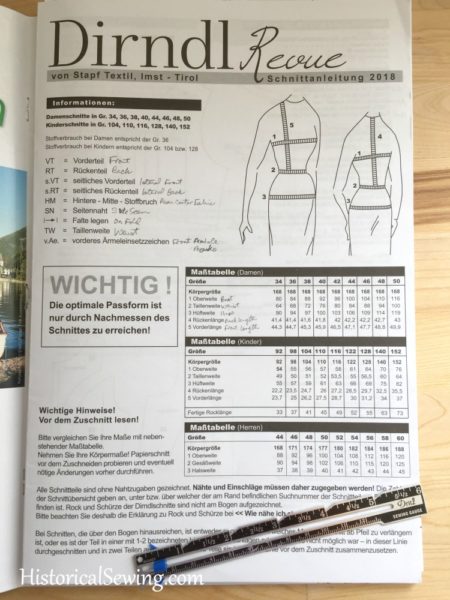
And on the sizing note, since we’re dealing with German and Austrian folk wear, patterns will be listed in centimeters and meters for sizes and fabric requirements. It’s a handy thing to know your bust, waist, hip, back length, front length, and bicep measurements in centimeters to make pattern selection and sewing easier.
(If you need a tape measure with centimeters and inches this one is a good one.)
For example, the size 46 in Dirndl Revue (Europe sizing) is: Bust 41” (104 cm), Waist 34.5” (88 cm), and Hips 43” (109 cm). This roughly translates to a Simplicity/Burda pattern size of 20.
The dirndl bodice is close fitting. As with other patterns it’s good to measure the actual pattern pieces to know the finished measurements and select your size accordingly.
Now, I haven’t scoured EVERY resource for possible dirndl patterns that are available. I’m sure there’s others out there. If you know of additional pattern options not listed here please add in the comments!
Happy Sewing!
P.S. If you are wanting to join the spring 2018 #DirndlChallenge then hop over to Doro’s blog, Dirndlschleifchen, to find out more including the Facebook group.
P.P.S. Here is the specific pattern section of my Pinterest board.
P.P.P.S. And for fabric selections, see my post here.

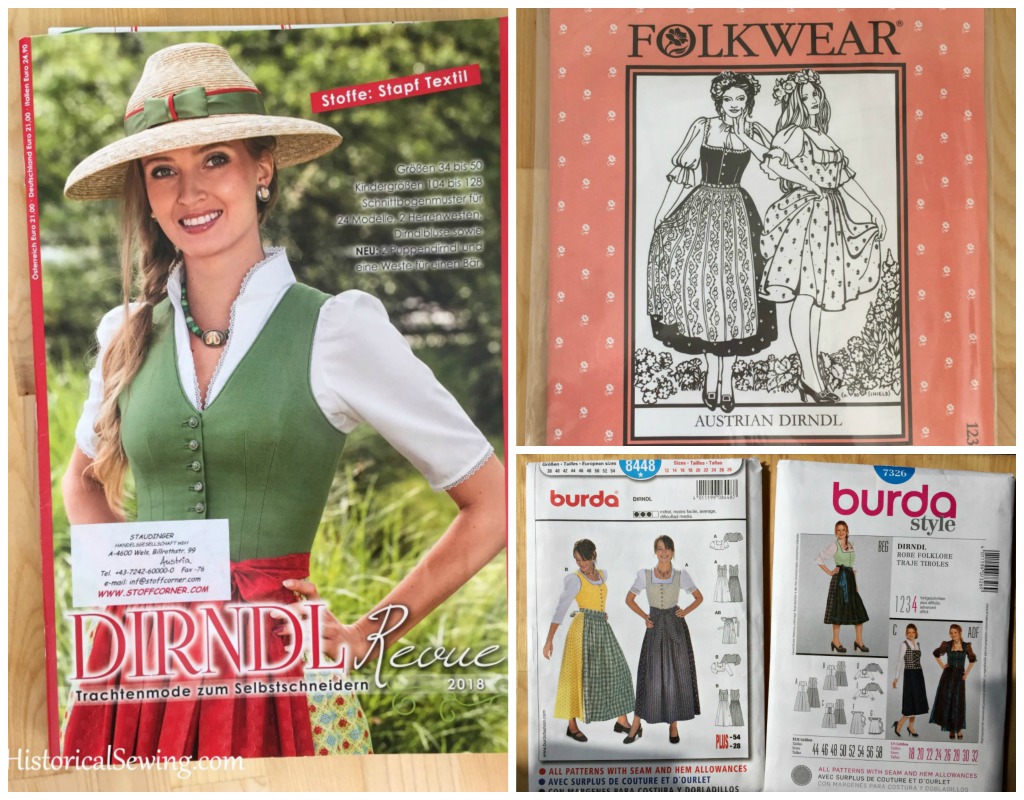
Hello Jennifer! I know this is an older post, but it looks like neither the Dirndl Fabric Shop nor the Dirndl Revue ship to the United States. Is this a new development or did you have to go somewhere else to get them?
Those sites may have changed their ship-to countries in recent times. I ordered mainly in 2018 and 2019, so with the craziness since 2020 they may have dropped international (outside EU) shipping. My last order of Dirndl Revues I sent to a friend in Italy who then mailed them onto me. So, if you have a friend in Europe willing to accept a package for you and are ok with double shipping then that’s a good way to go. If you haven’t, send those companies an email to double check. I know with Laura und Ben I initially did that. They may have options for you not shown on their website.
Hi Lily! I found this blog a few months ago and also started looking into Dirndl Revue to make my own! I came back today in search of a size chart/Masstabelle for the magazine. I’ve been in contact with a rep from Stapf Textil (the publisher of Dirndl Revue) and she said she can ship to the US. I emailed stapftextilmst@aon.at, and she’ll be getting me a special invoice soon. Note that all issues go up to size 48, some go up to size 50, and I’ve only found one that says on the cover that it goes up to a 52. As a plus size lady, I’m also asking her for advice on which issues to buy. I hope this helps!
I realize this is an older post, but Folkwear has updated their pattern to include plus sizes. The pattern now goes up to 3XL (bust 54 in, waist 49 in, and hip 56 in). At least, the PDF version has this information.
Yes! I saw that recently. I’m curious as to how it’s graded up to those large sizes. A new one to test!
Hi Jen. Super late on hoppin in here. Question
Is the dirndl skirt fabric cut on a bias?
Hi Betsy. No, dirndl skirts are cut on-grain. Although, I have seen some cut as circle skirts where the side seams would then be on the bias (naturally). But most are cut on grain/with selvedge or on the cross grain as for an embroidered or border hem.
How were you able to order Dindl Revue? Their website won’t allow deliveries to the US.
I’ve found a few Austrian and German sites that DO NOT ship to the US. However, Stoffcorner DOES ship to the US. This is where I purchased my Dirndl Revues. You can see their shipping rates on this page. Also, if you have a friend in a European country, you might ask if they would receive a shipment for you and then mail it to you in the US. I’ve done this before too, with getting dirndl fabrics/Dirndl Revue from an online company that doesn’t ship to the US.
Also, you might simply check Etsy and eBay for others that are selling their older Dirndl Revues. 🙂
I am trying to follow the Dirndl that you are making. I have a hard time finding where all the video is posted??
Thank you!!
Cindy King
Hi Cindy,
The few videos I’ve done on dirndls you can find in my specific playlist: Dirndl Obsession on Facebook on this page: https://www.facebook.com/pg/HistoricalSewing/videos/
Hope this helps!
Hello Jennifer,
So it sounds like that if I haven’t started sewing historic costume/clothing, it’s daunting to me, the dirndle would be a good place to start? Would it be like applying Victorian technique on a simpler scale? Perhaps I could advance from there?
Linda
Absolutely! To all your questions. You can use many Victorian techniques on a dirndl dress without risking expensive fabric or a mass of yardage yet still make something wearable while improving your skills. If you haven’t seen it yet, I did a Facebook Live video a while back on the techniques I was using in my first dirndl. You can watch it here. Good luck!
Hello Jennifer,
I love drindles too! They are such fun. I do have a quick side question. How do you recommend fitting period clothing, especially the 19th century with a small bust? I have found it difficult to achieve the period silhouette with not too much in the upper region…I have tried bust pads but they look very unnatural and odd. Any thoughts?
Thank you so much for sharing all of your expertise and congrats on having a child! It is no easy feat to take care of a young kid and a blog but your dedication is much appreciated!
<3 Thank you Camila.
Have you tried adding the bust pads into the bodice? (rather than in your corset) They used padding then too in various places. Perhaps a thick or padded corset cover? Also, on the padding you are using, perhaps re-think it... like use layers cut from cotton quilt batting rather than actual bust pads for a bra. And try the bust pads underneath the bust inside your corset to push the flesh up so YOU are visible with the pads merely supporting underneath like a push-up bra. These are options my small busted friends have used and I recommend. I can't speak about it personally as I'm a DDD cup. ;-) Best of luck finding a solution that works!